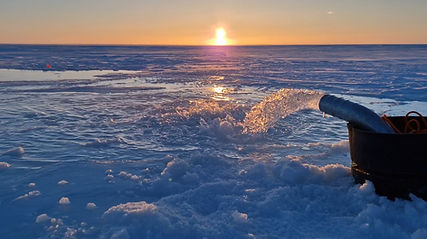Cambridge Bay, Nunavut Expedition - Engineering & Science Factsheet

In January, Real Ice led an expedition to the Canadian High Arctic Research Station (CHARS) with the permission, support and involvement of the Ekaluktutiak Hunters & Trappers Organisation and together with our research partners, the Centre for Climate Repair at Cambridge University and Arctic Reflections.
The goal was to progress through the next phase of our testing for sea ice thickening - in this test; we successfully used a Hydrogen-fuel-cell-powered water pump for the first time.

We created around 1,000 tonnes of new ice in an area the size of a football pitch.
We recorded snow and ice thickness several times in the re-iced area and a nearby “control area” that we left untouched. We observed different colours and salinity levels of new and old ice. We have a complete record of hourly weather conditions from the local weather station and continue monitoring the test and control areas.

OPERATIONS - We worked with our guides to select a suitable location for the research to remove any potential negative impact on humans or wildlife. Snowmobile and Qammutik (Sled) transported the team and equipment to the site about 5 km from Cambridge Bay. We utilised the twilight/daylight hours from 9 am - 3 pm to research our impact on the sea ice.
TECHNOLOGY - The Real Ice developed, first in the Arctic, hydrogen powered water pump performed well in the extreme environment (down to -46c). We created multiple re-icing layers in the same area and demonstrated re-icing with different snow covers. We observed sufficient re-icing cases to move to the next stage of our R&D.
KEY RESULTS FROM TRIP:
RE-ICED AREA - 4100m2 / ~1000 Tonnes of ice created On average: 25 cm of thickness added with areas surrounding the pump reaching over 30cm
ICE THICKNESS/LAYERS - The new ice showed a much lighter blue colour when compared with the old ice.
ICE SALINITY - The salinity measured tells us that some salt had travelled to the bottom of the new ice (values from 11 to 23 ppt in the new ice stack and 5 ppt on the old ice), indicating that there had been some brine movement from the top to the bottom of the newer ice, but not necessarily beyond that.
%20-%20high%20res%20Portrait%20Ice%20hole%20w_%20tape%20measure.jpg)
